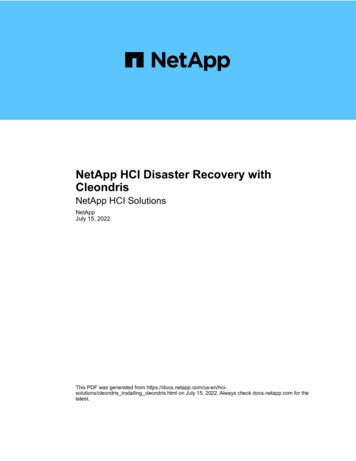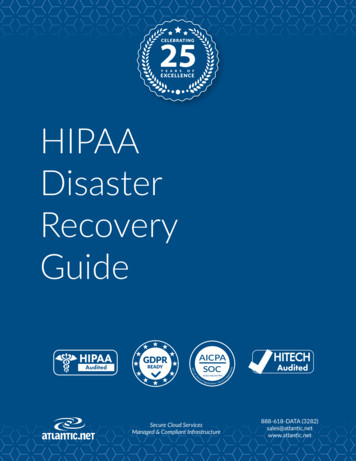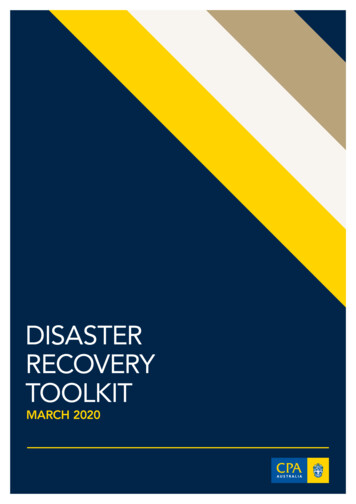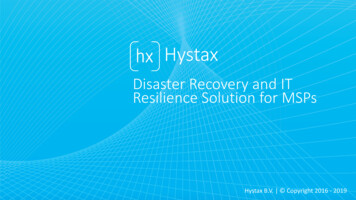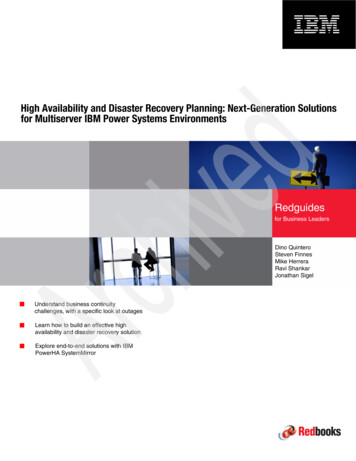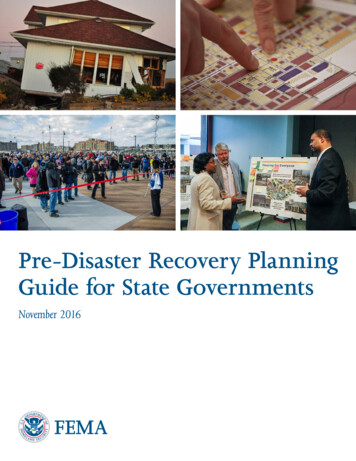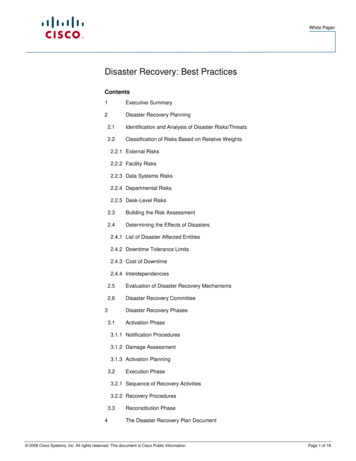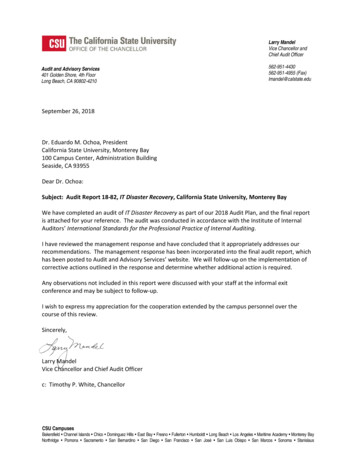
Transcription
Larry MandelVice Chancellor andChief Audit OfficerAudit and Advisory Services401 Golden Shore, 4th FloorLong Beach, CA 90802-4210562-951-4430562-951-4955 (Fax)lmandel@calstate.eduSeptember 26, 2018Dr. Eduardo M. Ochoa, PresidentCalifornia State University, Monterey Bay100 Campus Center, Administration BuildingSeaside, CA 93955Dear Dr. Ochoa:Subject: Audit Report 18-82, IT Disaster Recovery, California State University, Monterey BayWe have completed an audit of IT Disaster Recovery as part of our 2018 Audit Plan, and the final reportis attached for your reference. The audit was conducted in accordance with the Institute of InternalAuditors’ International Standards for the Professional Practice of Internal Auditing.I have reviewed the management response and have concluded that it appropriately addresses ourrecommendations. The management response has been incorporated into the final audit report, whichhas been posted to Audit and Advisory Services’ website. We will follow-up on the implementation ofcorrective actions outlined in the response and determine whether additional action is required.Any observations not included in this report were discussed with your staff at the informal exitconference and may be subject to follow-up.I wish to express my appreciation for the cooperation extended by the campus personnel over thecourse of this review.Sincerely,Larry MandelVice Chancellor and Chief Audit Officerc: Timothy P. White, ChancellorCSU CampusesBakersfield Channel Islands Chico Dominguez Hills East Bay Fresno Fullerton Humboldt Long Beach Los Angeles Maritime Academy Monterey BayNorthridge Pomona Sacramento San Bernardino San Diego San Francisco San José San Luis Obispo San Marcos Sonoma Stanislaus
CSUThe California State UniversityAudit and Advisory ServicesIT DISASTER RECOVERYCalifornia State University,Monterey BayAudit Report 18-82August 7, 2018
CALIFORNIA STATE UNIVERSITY, MONTEREY BAY – IT DISASTER RECOVERYEXECUTIVE SUMMARYOBJECTIVEThe objectives of this audit were to determine whether an appropriate governance structureexists to address program and facility readiness and resource planning for the recovery of dataprocessing services following a catastrophic event; to ascertain the effectiveness ofoperational and administrative controls related to information technology disaster recovery(ITDR) planning and preparedness; and to evaluate adherence to the Integrated CaliforniaState University Administrative Manual (ICSUAM) business continuity and disaster recoverypolicy and compliance with relevant regulations, Trustee policy, and other Office of theChancellor directives.CONCLUSIONBased upon the results of the work performed within the scope of the audit, except for theweaknesses described below, the operational and administrative controls for ITDR as of June 15,2018, taken as a whole, provided reasonable assurance that risks were being managed andobjectives were met.ITDR planning is a critical function of the information technology (IT) department and a keyelement of the overall campus business continuity plan. The central ITDR plan at California StateUniversity, Monterey Bay (CSUMB) and the business impact assessments (BIA) were current;however, recovery time expectations and the prioritized list of systems, as determined by IT, hadnot been clearly communicated to the campus community. Campus departments also had notdocumented manual procedures required to conduct business in the event that data-processingcapabilities were unavailable for an extended period. In addition, the campuswide ITDR plan didnot include a comprehensive test plan; however, the campus had implemented data restorationprocedures and redundant systems and facilities to help mitigate local disasters affecting theprimary data center.Specific observations, recommendations, and management responses are detailed in theremainder of the report.Audit Report 18-82Audit and Advisory ServicesPage 1
CALIFORNIA STATE UNIVERSITY, MONTEREY BAY – IT DISASTER RECOVERYOBSERVATIONS, RECOMMENDATIONS, AND RESPONSES1. BUSINESS CONTINUITY COORDINATION AND COMMUNICATIONOBSERVATIONRecovery time expectations and the prioritized list of systems, as determined by IT, had notbeen clearly communicated to the individual business units or campus departments.Specifically, we noted that information technology services (ITS) had not coordinated with theindividual business units to convey that data-processing outages could last for a minimum offive days and manual desk procedures may need to be followed until the systems could berestored.RECOMMENDATIONWe recommend that the campus develop an overall business continuity program to ensurethat business expectations are clearly communicated to the IT department, and convey thelength of time data-processing outages may last and whether manual desk procedures mayneed to be followed.MANAGEMENT RESPONSEWe concur. Risk Management, in coordination with the IT department, will augment ourbusiness continuity program (BCP) and ITDR program to ensure communication of businessexpectations from departments to IT and also ensure communication to departments ofprojected potential duration of data-processing outages and the possible transition to manualdesk procedures.Expected completion date: January 15, 20192. MANUAL PROCESSING DOCUMENTATIONOBSERVATIONCampus departments had not documented manual desk procedures that may be required toconduct business in the event that data-processing capabilities were unavailable for anextended period of time.RECOMMENDATIONWe recommend that the campus clearly document the manual desk procedures required toconduct critical business functions for those departments that use unique systems andapplications in the event data-processing services are unavailable for extended periods.Audit Report 18-82Audit and Advisory ServicesPage 2
CALIFORNIA STATE UNIVERSITY, MONTEREY BAY – IT DISASTER RECOVERYMANAGEMENT RESPONSEWe concur. We will support departments conducting critical business functions that rely onunique systems and applications to document manual desk procedures for implementationwhen data processing is unavailable for extended periods.Expected completion date: February 15, 20193. BUSINESS CONTINUITY AND DISASTER RECOVERY TEST PLANOBSERVATIONThe campus had not developed a comprehensive test plan nor performed tests to validate thebusiness continuity and ITDR plan strategy.EO 1014 requires that the campus create a detailed recovery test plan and that all keycomponents of the plan be tested within a seven-year time frame. Additionally, the absenceof a current, tested, and easily executable business continuity and ITDR plan could result inunnecessary financial and non-financial losses in the event of a disaster and create recoverydelays outside of management expectations.RECOMMENDATIONWe recommend that the campus develop a comprehensive test plan of the businesscontinuity and ITDR plans to provide support for assumptions in the plans, and perform teststo validate the established recovery time frame.MANAGEMENT RESPONSEWe concur. We will create a comprehensive schedule for testing and validating BCP and ITDRassumptions, including recovery time frames.Expected completion date: January 15, 2019Audit Report 18-82Audit and Advisory ServicesPage 3
CALIFORNIA STATE UNIVERSITY, MONTEREY BAY – IT DISASTER RECOVERYGENERAL INFORMATIONBACKGROUNDITDR planning is a specific subset of the campus business continuity planning process thataddresses how the IT resources required to operate critical business functions will be restored ina timely and effective manner following a disaster. ITDR planning requires the interaction ofindividuals at every level of an organization and a recognition by the organization that, intoday’s computer-driven work environment, the loss of data-processing capabilities can lead tosignificant financial loss and non-financial exposures if an organization has not planned properlyfor such an occurrence.The ITDR planning process requires the evaluation and consideration of several factors,including: Who will coordinate the recovery activities, and which supporting groups will report to thatcoordinator. How business units will be impacted if data-processing capabilities are lost. Which IT systems are critical to support those business units. How systems will be restored in the event of a disaster, whether alternate processingfacilities will be necessary, whether backup hardware should be stockpiled, and whetherinsurance coverage will be needed to cover the costs of recovery activities. The kind of training individuals involved with the recovery activities will need to ensure theywill be prepared to respond to a disaster in a concise and coordinated manner. What incidents have occurred in the past that tested the recovery capabilities of the ITsystems, how plans have been modified as a result of the incidents, and what simulatedtesting is required to refine the effectiveness of the plan.Because organizational and operational design variances exist between the 23 campuses andthe Office of the Chancellor, each campus process must consider many unique factors.Campuses have been directed to prepare ITDR plans for disasters via multiple directives,including, but not limited to, Executive Order (EO) 1014 and ICSUAM §8085.0.ICSUAM §8085.0, Business Continuity and Disaster Recovery, represents the most recent andspecific guidance to campuses in regard to ITDR planning. Simply stated, the policy directscampuses to ensure that information assets can continue to operate or, in a reasonable timeframe, be supplanted by backup systems so that minimal interruption of critical businessservices occurs in the event of a disaster or other emergency event. Although the policy itselfdoes not provide detailed operational requirements, it can be surmised that the campuses mustconsider a multitude of factors such as restart times, backup and recovery procedures, systemsecurity (environmental, physical, and logical), and system interdependence and redundancy toensure a satisfactory level of continued operational capacity.Audit Report 18-82Audit and Advisory ServicesPage 4
CALIFORNIA STATE UNIVERSITY, MONTEREY BAY – IT DISASTER RECOVERYAt CSUMB, the campuswide ITDR plan is centrally managed by the chief information officer, whooversees all IT departments and resources, including those servicing the University Corporationand Foundation auxiliary organizations. The enterprise risk management and emergencymanagement departments serve as the lead coordinating departments for the campuswidebusiness continuity plan and disaster recovery preparedness, response, and mitigation. ITDRwas last audited at CSUMB in 2010.SCOPEWe visited the CSUMB campus from May 21, 2018, through June 15, 2018. Our audit andevaluation included the audit tests we considered necessary in determining whether operationaland administrative controls are in place and operative. The audit focused on procedures ineffect from January 1, 2017, through June 15, 2018.Specifically, we reviewed and tested: The administration of the ITDR program to ensure there is a defined mission, stated goalsand objectives, clear lines of organizational authority and responsibility, and adequatefunding. Whether the ITDR plan is reviewed and modified on a regular basis, modifications reflect theneeds of the campus and business units, and plans are integrated with the campus businesscontinuity plan. Whether the campus business unit’s business impact assessments are considered indetermining the prioritization of systems and their recovery time expectations. Whether an adequate emergency operations center (EOC) exists; sufficient equipment,supplies, and other critical resources are properly provisioned; and the campus is fullyprepared for emergencies affecting data-processing activities. The ITDR plan to determine whether it clearly identifies who has authority and responsibilityfor emergencies and incidents and whether the emergency organization is sufficient toensure that campus command/incident command techniques provide command and controlwhen emergency incidents occur. The adequacy of system redundancy or alternate processes that were developed to ensureminimal interruption of critical business services. System backups and record retention to ensure they are sufficient to meet the recoveryobjectives of the campus. Training to ensure that it has been provided to employees, disaster recovery staff, andbuilding marshals who are expected to execute the ITDR plan. Whether routinely scheduled simulated tests of plan components are conducted. Whether end-user desk procedures define the actions required to adequately synchronizedata recovery and restoration efforts.As a result of changing conditions and the degree of compliance with procedures, theeffectiveness of controls changes over time. Specific limitations that may hinder theAudit Report 18-82Audit and Advisory ServicesPage 5
CALIFORNIA STATE UNIVERSITY, MONTEREY BAY – IT DISASTER RECOVERYeffectiveness of an otherwise adequate system of controls include, but are not limited to,resource constraints, faulty judgments, unintentional errors, circumvention by collusion, andmanagement overrides. Establishing controls that would prevent all these limitations would notbe cost-effective; moreover, an audit may not always detect these limitations.Our testing and methodology was designed to provide a managerial-level review of ITDRpractices, which included campus policy; governance and risk management; completeness ofplanning documentation, including replacement equipment contract details and recoveryprovisions; security and adequacy of data center and alternative site controls; data backup andavailability; and manual operating desk procedures. Our testing approach was designed toprovide a broad view of controls surrounding ITDR practices.CRITERIAOur audit was based upon standards as set forth in California State University Board of Trusteepolicies; Office of the Chancellor policies, letters, and directives; campus policies andprocedures; and other sound administrative practices. This audit was conducted inconformance with the Institute of Internal Auditors’ International Standards for the ProfessionalPractice of Internal Auditing.This review emphasized, but was not limited to, compliance with: ICSUAM §8085.0, Business Continuity and Disaster RecoveryEO 1014, California State University Business Continuity ProgramAUDIT TEAMIT Audit Manager: Greg DoveSenior IT Auditor: Summy VoongAudit Report 18-82Audit and Advisory ServicesPage 6
Subject: Audit Report 18-82, IT Disaster Recovery, California State University, Monterey Bay . . Based upon the results of the work performed within the scope of the audit, except for the . EO 1014 requires that the campus create a detailed recovery test plan and that all key components of the plan be tested within a seven-year time frame .




